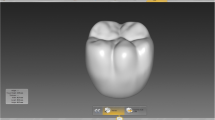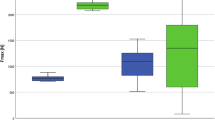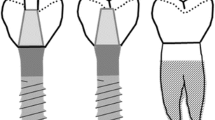Abstract
Objectives
Indirect CAD/CAM restorations can be fabricated using both subtractive and additive CAD/CAM technology. This study investigated the fracture load of crowns fabricated from three particle-filled composite CAD/CAM materials and one 3D-printed composite material.
Materials and methods
Lava Ultimate, Cerasmart and Brilliant Crios were used as particle-filled composite CAD/CAM material and els-3D Harz as 3D-printed composite material. For each group, crowns with three different material thicknesses (0.5/1.0/1.5 mm) were fabricated. Control group was composed of ceramic-based CAD/CAM materials e.max CAD and Enamic. Totally, n = 180 crowns were fabricated and adhesively seated on SLA fabricated dies. Thermomechanical loading and fracture testing were performed. The data for fracture loading force were statistically analyzed by two-way ANOVA followed with multiple comparisons by post hoc Tukey’s test (α = 0.05).
Results
In contrast to ceramics, all particle-filled composite crowns with 0.5-mm thickness survived fatigue testing. Forces varied statistically significantly. Brilliant Crios showed highest maximum loading force with 1580.4 ± 521.0 N (1.5 mm). Two-way ANOVA indicated that both the material and the thickness affected the fracture load (p < 0.05).
Conclusions
Particle-filled composite resin CAD/CAM materials may have advantageous material characteristics compared to ceramic CAD/CAM materials for minimal restoration thicknesses.
Clinical relevance
Composite-based CAD/CAM materials may offer new possibilities in minimally invasive restorative treatment concepts.


Similar content being viewed by others
References
Thompson VP, Rekow DE (2004) Dental ceramics and the molar crown testing ground. J Appl Oral Sci 12(spec):26–36
Ruse ND, Sadoun MJ (2014) Resin-composite blocks for dental CAD/CAM applications. J Dent Res 93:1232–1234
Spitznagel FA, Horvath SD, Guess PC, Blatz MB (2014) Resin bond to indirect composite and new ceramic/polymer materials: a review of the literature. J Esthet Restor Dent 26:382–393
Alharbi A, Ardu S, Bortolotto T, Krejci I (2017) Stain susceptibility of composite and ceramic CAD/CAM blocks versus direct resin composites with different resinous matrices. Odontology 105:162–169
Kamonwanon P, Hirose N, Yamaguchi S, Sasaki JI, Kitagawa H, Kitagawa R, Thaweboon S, Srikhirin T, Imazato S (2017) SiO2-nanocomposite film coating of CAD/CAM composite resin blocks improves surface hardness and reduces susceptibility to bacterial adhesion. Dent Mater J 36:88–94
Zimmermann M, Mehl A, Reich S (2013) New CAD/CAM materials and blocks for chairside procedures. Int J Comput Dent 16:173–181
Goujat A, Abouelleil H, Colon P, Jeannin C, Pradelle N, Seux D, Grosgogeat B (2018) Mechanical properties and internal fit of 4 CAD-CAM block materials. J Prosthet Dent 119:384–389
Zimmerman M, Koller C, Reymus M, Mehl A, Hickel R (2017) Clinical evaluation of indirect particle-filled composite resin CAD/CAM partial crowns after 24 months. J Prosthodont 27:694–699. https://doi.org/10.1111/jopr.12582
Shembish FA, Tong H, Kaizer M, Janal MN, Thompson VP, Opdam NJ, Zhang Y (2016) Fatigue resistance of CAD/CAM resin composite molar crowns. Dent Mater 32:499–509
Schlichting LH, Maia HP, Baratieri LN, Magne P (2011) Novel-design ultra-thin CAD/CAM composite resin and ceramic occlusal veneers for the treatment of severe dental erosion. J Prosthet Dent 105:217–226
Magne P, Schlichting LH, Maia HP, Barattieri LN (2010) In vitro fatigue resistance of CAD/CAM composite resin and ceramic posterior occlusal veneers. J Prosthet Dent 104:149–157
Magne P, Stanley K, Schlichting LH (2012) Modeling of ultrathin occlusal veneers. Dent Mater 28:777–782
El-Damanhoury HM, Haj-Ali RN, Platt JA (2015) Fracture resistance and microleakage of endocrowns utilizing three CAD-CAM blocks. Oper Dent 40:201–210
Krejci I, Reich T, Lutz F, Albertoni M (1990) An in vitro test procedure for evaluating dental restoration systems. 1. A computer-controlled mastication simulator. Schweiz Monatsschr Zahnmed 100:953–960
Scherrer SS, de Rijk WG (1992) The effect of crown length on the fracture resistance of posterior porcelain and glass-ceramic crowns. Int J Prosthodont 5:550–557
Rosentritt M, Plein T, Kolbeck C, Behr M, Handel G (2000) In vitro fracture force and marginal adaptation of ceramic crowns fixed on natural and artificial teeth. Int J Prosthodont 13:387–391
Guess PC, Schultheis S, Wolkewitz M, Zhang Y, Strub JR (2013) Influence of preparation design and ceramic thicknesses on fracture resistance and failure modes of premolar partial coverage restorations. J Prosthet Dent 110:264–273
May LG, Kelly JR, Bottino MA, Hill T (2012) Effects of cement thickness and bonding on the failure loads of CAD/CAM ceramic crowns: multi-physics FEA modeling and monotonic testing. Dent Mater 28:99–109
Sarabi N, Ghavamnasiri M, Forooghbakhsh A (2009) The influence of adhesive luting systems on bond strength and failure mode of an indirect micro ceramic resin-based composite veneer. J Contemp Dent Pract 10:33–40
D'Arcangelo C, De Angelis F, D’Amario M, Zazzeroni S, Ciampoli C, Caputi S (2009) The influence of luting systems on the microtensile bond strength of dentin to indirect resin-based composite and ceramic restorations. Oper Dent 34:328–336
Rekow ED, Harsono M, Janal M, Thompson VP, Zhang G (2006) Factorial analysis of variables influencing stress in all-ceramic crowns. Dent Mater 22:125–132
Scherrer SS, de Rijk WG (1993) The fracture resistance of all-ceramic crowns on supporting structures with different elastic moduli. Int J Prosthodont 6:462–467
Kinney JH, Marshall SJ, Marshall GW (2003) The mechanical properties of human dentin: a critical review and re-evaluation of the dental literature. Crit Rev Oral Biol Med 14:13–29
Yang R, Arola D, Han Z, Zhang X (2014) A comparison of the fracture resistance of three machinable ceramics after thermal and mechanical fatigue. J Prosthet Dent 112:878–885
Kelly JR (1995) Perspectives on strength. Dent Mater 11:103–110
Kelly JR (1999) Clinically relevant approach to failure testing of all-ceramic restorations. J Prosthet Dent 81:652–661
Al-Akhali M, Chaar MS, Elsayed A, Samran A, Kern M (2017) Fracture resistance of ceramic and polymer-based occlusal veneer restorations. J Mech Behav Biomed Mater 74:245–250
Edelhoff D, Sorensen JA (2002) Tooth structure removal associated with various preparation designs for anterior teeth. J Prosthet Dent 87:503–509
Edelhoff D, Sorensen JA (2002) Tooth structure removal associated with various preparation designs for posterior teeth. Int J Periodontics Restorative Dent 22:241–249
Davis GR, Tayeb RA, Seymour KG, Cherukara GP (2012) Quantification of residual dentine thickness following crown preparation. J Dent 40:571–576
Quinn GD, Hoffman K, Quinn JB (2012) Strength and fracture origins of a feldspathic porcelain. Dent Mater 28:502–511
Mörmann WH, Stawarczyk B, Ender A, Sener B, Attin T, Mehl A (2013) Wear characteristics of current aesthetic dental restorative CAD/CAM materials: two-body wear, gloss retention, roughness and martens hardness. J Mech Behav Biomed Mater 20:113–125
Kirsch C, Ender A, Attin T, Mehl A (2017) Trueness of four different milling procedures used in dental CAD/CAM systems. Clin Oral Investig 21(2):551–558
Argyrou R, Thompson GA, Cho SH, Berzins DW (2016) Edge chipping resistance and flexural strength of polymer infiltrated ceramic network and resin nanoceramic restorative materials. J Prosthet Dent 116:397–403
Quinn GD, Giuseppetti AA, Hoffman KH (2014) Chipping fracture resistance of dental CAD/CAM restorative materials: part I—procedures and results. Dent Mater 30:99–111
Mörmann WH, Bindl A, Lüthy H, Rathke A (1998) Effects of preparation and luting system on all-ceramic computer-generated crowns. Int J Prosthodont 11:333–339
Scherrer SS, de Rijk WG, Belser UC, Meyer JM (1994) Effect of cement film thickness on the fracture resistance of a machinable glass-ceramic. Dent Mater 10:172–177
Bindl A, Luthy H, Mörmann WH (2006) Strength and fracture pattern of monolithic CAD/CAM-generated posterior crowns. Dent Mater 22:29–36
Duan Y, Griggs JA (2015) Effect of elasticity on stress distribution in CAD/CAM dental crowns: glass ceramic vs. polymer-matrix composite. J Dent 43:742–749
Dejak B, Mlotkowski A, Langot C (2012) Three-dimensional finite element analysis of molars with thin-walled prosthetic crowns made of various materials. Dent Mater 28:433–441
Krejci I, Daher R (2017) Stress distribution difference between lava ultimate full crowns and IPS e.max CAD full crowns on a natural tooth and on tooth-shaped implant abutments. Odontology 105:254–256
Gilbert S, Keul C, Roos M, Edelhoff D, Stawarczyk B (2016) Bonding between CAD/CAM resin and resin composite cements dependent on bonding agents: three different in vitro test methods. Clin Oral Investig 20:227–236
Bähr N, Keul C, Edelhoff D, Eichberger M, Roos M, Gernet W, Stawarczyk B (2013) Effect of different adhesives combined with two resin composite cements on shear bond strength to polymeric CAD/CAM materials. Dent Mater J 32:492–501
Stawarczyk B, Krawczuk A, Ilie N (2015) Tensile bond strength of resin composite repair in vitro using different surface preparation conditionings to an aged CAD/CAM resin nanoceramic. Clin Oral Investig 19:299–308
Nobuaki A, Keiichi Y, Takashi S (2015) Effects of air abrasion with alumina or glass beads on surface characteristics of CAD/CAM composite materials and the bond strength of resin cements. J Appl Oral Sci 23:629–636
Lise DP, Van Ende A, De Munck J, Vieira L, Baratieri LN, Van Meerbeck B (2017) Microtensile bond strength of composite cement to novel CAD/CAM materials as a function of surface treatment and aging. Oper Dent 42:73–81
Schepke U, Meijer HJ, Vermeulen KM, Raghoebar CMS (2016) Clinical bonding of resin nano ceramic restorations to zirconia abutments: a case series within a randomized clinical trial. Clin Implant Dent Relat Res 18:984–992
Lohbauer U, Belli R, Cune MS, Schepke U (2017) Fractography of clinically fractured, implant-supported dental computer-aided design and computer-aided manufacturing crowns. SAGE Open Med Case Rep 5:2050313x17741015
Belli R, Wendler M, de Ligny D, Cicconi MR, Petschelt A, Peterlik H, Lohbauer U (2017) Chairside CAD/CAM materials. Part 1: measurement of elastic constants and microstructural characterization. Dent Mater 33:84–98
Wendler M, Belli R, Petschelt A, Mevec D, Harrer W, Lube T, Danzer R, Lohbauer U (2017) Chairside CAD/CAM materials. Part 2: flexural strength testing. Dent Mater 33:99–109
Shah MB, Ferracane JL, Kruzic JJ (2009) R-curve behavior and micromechanisms of fracture in resin based dental restorative composites. J Mech Behav Biomed Mater 2:502–511
Wendler M, Belli R, Valladares D, Petschelt A, Lohbauer U (2018) Chairside CAD/CAM materials. Part 3: cyclic fatigue parameters and lifetime predictions. Dent Mater 34:910–921
Blackburn C, Rask H, Awada A (2018) Mechanical properties of resin-ceramic CAD-CAM materials after accelerated aging. J Prosthet Dent 119:954–958
Funding
The work was supported by the Division of Computerized Restorative Dentistry, Center of Dental Medicine, University of Zurich.
Author information
Authors and Affiliations
Corresponding author
Ethics declarations
Conflict of interest
The authors declare that they have no conflict of interest.
Ethical approval
This article does not contain any studies with human participants or animals performed by any of the authors.
Informed consent
For this type of study, formal consent is not required.
Rights and permissions
About this article
Cite this article
Zimmermann, M., Ender, A., Egli, G. et al. Fracture load of CAD/CAM-fabricated and 3D-printed composite crowns as a function of material thickness. Clin Oral Invest 23, 2777–2784 (2019). https://doi.org/10.1007/s00784-018-2717-2
Received:
Accepted:
Published:
Issue Date:
DOI: https://doi.org/10.1007/s00784-018-2717-2




